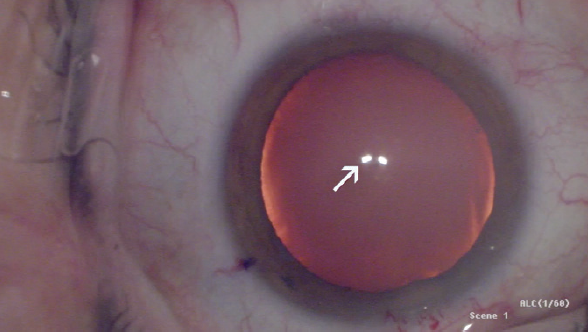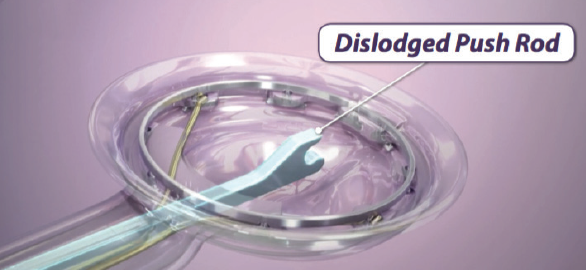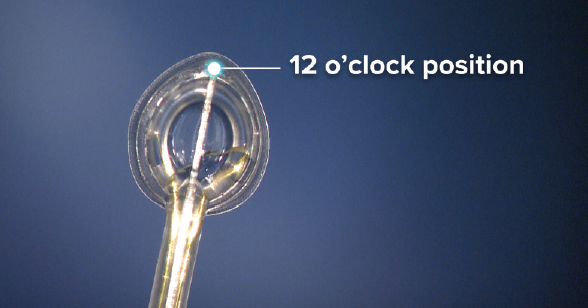
Kevin L. Waltz, OD, MD
• President, Ophthalmic Research Consultants, Indianapolis
• Chairman, Board of Directors, Central American Eye Clinics
• kwaltz56@gmail.com
• Financial disclosure: Consultant (Centricity Vision)

Ehsan Sadri, MD
• Visionary Eye Institute, Newport Beach, California
• esadrii@gmail.com
• Financial disclosure: Consultant (Centricity Vision)

Tomy Starck, MD
• UltraVision, San Antonio, Texas
• Tomystarckmd@gmail.com
• Financial disclosure: Consultant (Centricity Vision)
At a Glance
- Precision pulse capsulotomy (PPC) with the Zepto device (Centricity Vision) has been shown to be a safe, effective, and efficient alternative to continuous curvilinear capsulorhexis (CCC) and laser-based capsulotomy, allowing surgeons to experience the potential benefits of visual axis centration.
- PPC may be useful in advanced technology IOLs, complex cataract cases, and standard cataract cases.
- Centricity Vision has collaborated with surgeon-innovators not only to continuously improve PPC, but also to enhance the safety and efficacy of Zepto.
Capsulotomy creation is among the most difficult steps of cataract surgery. The desire to create a consistent incision has led surgeon-innovators to develop a number of technologies that increase reproducibility, often at the expense of efficiency and monetary considerations. Zepto (Centricity Vision) is a device that creates a visual axis-anchored, accurate, precise, round, and reproducible capsulotomy in .004 seconds without the cost or efficiency barriers required of other new (ie, laser-based) technologies. In other words, Zepto allows laser-like results without incurring laser-like costs, and serves as a low-capital investment compared with laser-based technologies.
Innovation has been challenged to meet the demand for reproducible results. Femtosecond laser-assisted cataract surgery (FLACS) is among the most visible new technologies that have attempted to rise to the occasion, but many surgeons have found this technology wanting. Indeed, the ASCRS found that 43% of respondents said the lack of outcomes data showing a clinical benefit of FLACS prevented them from using the technology.1 More than 25% of respondents said that interference in patient flow, needs for additional time, and overall reductions in efficiency were a barrier to use.1 Further, economic barriers associated with FLACS have limited its integration into ORs. This has resulted in only approximately 8% of patients receiving FLACS.1
Despite being, as described by Sharma et al,2 the “technique of choice for anterior capsulotomy,” continuous curvilinear capsulorhexis (CCC) has been shown in the literature to have complications such as anterior capsule radial tears,3 rhexis breach,3 dysphotopsias,4 and compromised retinal images in a decentered capsulotomy.4 Innovators’ challenge is to address CCC’s safety concerns without disrupting the integrated workflow CCC allows.
Zepto technology allows precision pulse capsulotomy (PPC), which we consider an alternative to CCC as much as it is an alternative to FLACS. By combining the wisdom of older techniques such as CCC (which relied on surgical skill but was more integrated into a cataract surgery protocol) with the techy-savvy milieu of FLACS (which was born of engineering acumen but required a somewhat challenging integration into the OR), PPC results in an innovation that represents the best of both surgical frameworks.
EFFICACY, EFFICIENCY, & ACCESSIBILITY
A surgical practice’s efficacy, efficiency, and accessibility dictate the success of the practice. This is defined by a practice’s ability to run as a sound and solvent business that ultimately prioritizes patients. Efficacy, efficiency, and accessibility sometimes compete with each other—that is, in certain instances, an effective surgery is not always an efficient surgery. However, by performing PPC and adding Zepto to the OR, simultaneous enhancement of efficacy, efficiency, and accessibility may be achieved.
Efficacy
A 2020 paper by Ifantides et al5 reviewed 337 cataract surgeries that employed PPC. The authors reported free-floating capsulotomy was achieved in all but two cases (99.4%), and wrote that “little variation was observed in achieving [free-floating] capsulotomies with ~5-mm diameter and complete capsular overlap.”
Femtosecond laser is a very effective tool. It is also very expensive and time-consuming. Chang et al6 reported that FLACS resulted in a more precise diameter and a uniformly more circular incision compared with CCC. Still, the literature has shown that FLACS leaves something to be desired. Published reports showing high rates of anterior capsule tearing following FLACS7—particularly those showing anterior capsule tear rates to be significantly higher in patients who underwent FLACS compared with those who underwent phacoemulsification cataract surgery8—may be cause for concern when one considers that Ifantides et al found no cases of anterior capsule tearing in 337 cases that used PPC.5 And for all of its promise, it turns out that FLACS may not be superior to CCC at all: a 2020 study by Daya et al9 found that the strength of a capsulotomy edge was significantly stronger when CCC was used compared with FLACS.
Regarding the utility of FLACS, surgeons may have come to similar conclusions via personal experience rather than controlled studies. In a 2016 ASCRS survey,1 49% of respondents said FLACS did not provide a clinical benefit compared with conventional cataract surgery when it came to capsulorhexis creation.
Efficiency
A disposable tool such as Zepto is one of the best integrations of traditional surgical techniques and modern surgical technology: it allows the surgeon to perform a visual axis–anchored capsulotomy with a high degree of reproducibility (the most attractive feature of laser-based technologies) without inviting disruption into the OR (the most attractive feature of manual capsulorhexis). Visual axis centration encourages improved predictability of effective lens positioning.
A number of peer-reviewed papers have discussed Zepto’s smooth integration in a cataract surgery routine.5,6 Chang described the difficulty of incorporating FLACS to an OR work pattern, noting that “the [femtosecond laser’s] large size and the need for eye docking create surgical efficiency and workflow challenges.”5
Those who are worried about an inefficient integration of the device into surgical settings, which would thereby offset any potential long-term gains in overall surgical efficiency, should turn to the description of the device by Waltz et al. In their evaluation of Zepto and PPC, the authors noted that PPC “had a short learning curve and was integrated seamlessly into the surgical routine.”10 Further, the authors wrote that “The ease of use, consistency, and efficiency of PPC capsulotomy might support its use under many practice scenarios.”10
In the experience of these authors, Zepto is just as efficient as (if not more efficient than) CCC for capsulotomy creation. The consistency provided by Zepto as described separately by Ifantides5 and Waltz10 may alleviate concerns surgeons have about the reproducibility of manual procedures such as CCC.
Increased efficiency fosters a practice’s business growth as well as surgical strength, and serves patients. Patients who spend less time in the OR may experience reduced risk of intraoperative complications.11 By reducing per-session surgical times, anterior segment surgeons may be able to extend their community reach by seeing more patients. Alternatively, surgeons who manage private practices may spend more time and resources managing the business aspects of private practice without sacrificing patient volume, safety, or efficacy.
Accessibility
In reporting their retrospective analysis of 337 cataract surgeries using PPC, Ifantides et al concluded that “PPC was found to be highly versatile in challenging cataract surgeries that presented one or more clinical considerations that would complicate [CCC].”5 For example, the authors found that the consistency and control afforded by PPC was useful in cases of cataract surgery following removal of an intraocular foreign body, and that the clear window of the Zepto suction cup was advantageous in centering a capsulotomy over a traumatic cataract. When encountering a white cataract with a tense anterior capsule, use of Zepto may avoid complications such as the Argentinian flag sign.
In a 2019 study, Park et al12 studied the safety and efficacy of PPC in 43 eyes (35 patients) that presented with complications such as poorly dilated pupils, anterior subcapsular opacity, white cataract, brunescent cataract, or corneal opacity. All eyes in the study received “circular, 360° free-floating, and appropriately sized anterior capsulotomies,” and there were no cases of anterior capsular tears. Patients were evaluated 2 months after surgery, and there were no reported complications associated with Zepto.
During PPC, the capsulotomy is centered on the visual axis thanks to the clear window that invites patient fixation on the light of a coaxial microscope eyepiece (Figure 1). Chang reported that this is useful during placement of a multifocal or EDOF IOL.6 When implanting a premium IOL, use of image-guided centration platforms may add to the accuracy of the Zepto ring positioning, as well as the IOL centration.

Figure 1. The patient was asked to maintain fixation on the left microscope light (arrow) while the surgeon looked through the corresponding eye piece coaxial to the light. This anchored cataract surgery to the patient’s visual axis.
Image credit: Vance Thompson, MD.
SURGICAL PEARLS
Centricity Vision has worked with Zepto innovators to learn about which steps in the surgical process are most vital and has listened to surgeons about which adjustments to the surgical procedure can enhance surgical outcomes. Here, we share a few surgical pearls that the company has learned.
Inspection of the handpiece tip is a critical first step. By confirming that the pushrod is not dislodged from the nitinol capsulotomy ring (Figure 2) and that the pushrod engages the nitinol ring at the 12 o’clock position (Figure 3), you ensure that the device is functional and ready for use.

Figure 2. If a dislodged pushrod is observed during initial inspection, then the Zepto handpiece should be replaced with one that shows an in-place pushrod.

Figure 3. The pushrod should engage the nitinol ring at the 12 o’clock position.
Insertion of Zepto is done through an incision that is 2.2 mm or greater with a firm grip on the handpiece. The OVD that is placed in the anterior chamber may also be used near the incision to aid insertion, and a countertraction device such as a Thornton ring may help stabilize the eye at this step (Figure 4). Alternatively, introduction of a second instrument in the paracentesis site may stabilize the eye to facilitate introduction of the Zepto device.

Figure 4. The opening of a Thornton ring, which provides a countertraction force during insertion, aligns with the incisional opening.
Image credit: Vance Thompson, MD.
After the pushrod is retracted and the Zepto’s circular tip reforms into a circle, moving the tip on the capsule in a circular fashion will ensure complete unfolding of the flange and will allow the suction cup to be seated on the capsule. During cases involving borderline dilation that do not meet the criteria for iris dilator use, the surgeon must verify that the flange is entirely beneath the iris. This is a critical step, as engaging suction over the iris may produce significant disruption and subsequent atrophy.
The surgeon should keep his or her grip and wrist relaxed during this period. Raising the cable end of the device 10° to 20° above parallel and keeping the tip in a downward position allows the tip of the device to engage the capsule fully and create adequate suction (Figure 5).

Figure 5. The heel of the Zepto device should be elevated from its initial position (A) to a position 10° to 20° above parallel (B) while keeping the tip of the device in position.
Image credit: Ehsan Sadri, MD.
The surgeons should say “suction,” to the surgical assistant, alerting them to engage the device’s suction function (remember to relax the grip on the handpiece at this time). After waiting 2 seconds and retracting the pushrod to the end of travel, full suction will be engaged; neglecting to fully retract the pushrod from the smaller lumen of the handpiece’s surgical tubing may result in less-than-maximum suction and may encourage complications.
The surgical assistant will alert the surgeon when the device’s power console indicates that suction has been achieved. The surgeon must confirm that full suction has occurred by verifying that any small bubbles migrating toward the device’s lumen have stopped moving. The surgeon should say, “bubbles have stopped; max suction,” so that the surgical team knows that this step has been completed. Surgeons must be patient during this step. The continuous movement of bubbles, particularly at the junction of the circle (12 o’clock surgeon’s position), may take 5 to 10 seconds. Engaging the energy function before the bubbles have stopped moving may lead to inadequate contact, which could potentially lead to an area of capsulotomy weakness that could cause a secondary tear.
At this point, the surgeon should instruct the surgical assistant to apply energy by saying “energy,” which should be repeated back by the surgical assistant. The surgical assistant will press the cut/release button on the Zepto power console. In the span of 4 milliseconds, 12 micropulses of energy will be released. Water molecules in the liquid phase, trapped at the edge of the nitinol ring adjacent to the anterior capsule, undergo a phase effect change to the gaseous state, and a capsulotomy is created.
The surgeon should pause for 1 second after the capsulotomy is created and then say “release.” A surgical assistant will push a roller along the suction line and release 0.2 mL of balanced salt solution and OVD, which releases the suction cup from the capsule.
Pushing the device slightly forward and lifting it slightly up will assist in removing the device from the capsule (Figure 6). The surgeon should return the device, so it is parallel to the plane of the iris (ie, revert from 10° to 20° angle that was previously employed). The tip of the device will collapse on itself as it is removed from the anterior chamber (Figure 7). Cataract surgery proceeds normally from this point.

Figure 6. By lifting up the tip of the Zepto device and moving it slightly forward, the device will release from the capsule.
Image credit: Ehsan Sadri, MD.

Figure 7. The tip of the Zepto device will collapse upon itself during extraction.
Image credit: Ehsan Sadri, MD.
CONCLUSION
Effective and efficient surgeries will be key to keeping up with the rapidly aging population that will require more cataract surgery in the coming decades. Devices such as Zepto that allow the precision of modern laser procedures but do not require major adjustments to surgical routines or hefty price tags may be key to scaling our ORs for the coming wave of patients. PPC will be one of the keys to fostering sound practices that remain financially stable and are able to help as many patients as possible.
In a post-COVID world, adding Zepto to your surgical armamentarium decreases surgical times for complex cataract cases, thereby increasing efficiency and helping alleviate surgical backlogs. Further, Zepto encourages predictable surgical outcomes by delivering more precise, circular, and centered capsulotomies. If you are considering adding a new technology to your OR, consider Zepto.
FURTHER QUESTIONS?
Centricity Vision has resources for customers and potential Zepto users.
Learn More About Zepto: www.zeptozone.com
Zepto 360 Customer Care: 1-833-33-ZEPTO (93786)
Coding & Reimbursement: www.corcoranccg.com
1. Global Trends in Ophthalmology and the American Society of Cataract and Refractive Surgery. ASCRS Clinical Survey 2016.
2. Sharma B, Abell RG, Arora T, et al. Techniques of anterior capsulotomy in cataract surgery. Indian J Ophthalmol. 2019;67(4):450-460.
3. Olali CA, Ahmed S, Gupta M. Surgical outcome following breach rhexis. Eur J Ophthalmol. 2007;17:565-570.
4. Wirtitsch MG, Findl O, Menapace R, et al. Effect of haptic design on change in axial lens position after cataract surgery. J Cataract Refract Surg. 2004;30:45-51.
5. Ifantides C, Lee J, Rouweyha R, et al. Precision cataract capsulotomy: performance metrics and utility in routine and complex cases [published online ahead of print July 13, 2020]. J Cataract Refract Surg.
6. Chang DF. Zepto precision pulse capsulotomy: a new automated and disposable capsulotomy technology. Indian J Ophthalmol. 2017;65(12):1411-1414.
7. Chang JS, Chen IN, Chan WM, et al. Initial evaluation of a femtosecond laser system in cataract surgery. J Cataract Refract Surg. 2014;40:29-36.
8. Abell RG, Davies PE, Phelan D, et al. Anterior capsulotomy integrity after femtosecond laser–assisted cataract surgery. Ophthalmology. 2014;121:17-24.
9. Daya S, Soon-Phaik C, Ti S, et al. Comparison of anterior capsulotomy techniques: continuous curvilinear capsulorhexis, femtosecond laser-assisted capsulotomy and selective laser capsulotomy. Br J Ophthalmol. 2020;104(3):437-442.
10. Waltz K, Thompson VM, Quesada G. Precision pulse capsulotomy: initial clinical experience in simple and challenging cataract surgery cases. J Cataract Refract Surg. 2017;43(5):606-614.
11. Stein JD. Serious adverse events after cataract surgery. Curr Opin Ophthalmol. 2012;23(3):219-225.
12. Park MJ, Bang CW, Han SY. Precision pulse capsulotomy in challenging cataract surgery cases. Clin Ophthamol. 2019;13:1361-1368.
INDICATIONS FOR USE
The ZEPTO® System is indicated for use in performing anterior capsulotomy during cataract surgery.
CONTRAINDICATIONS
Any contraindications to cataract surgery, including:
- Buphthalmos
- Microphthalmos
- Pediatric
WARNINGS
- Contents sterile unless package is opened or damaged.
- The disposable ZEPTO® Handpiece is single use only. Do not re-sterilize, autoclave or reuse. Discard opened unused product.
- Do not use past expiration date.
PRECAUTIONS
- US Federal law restricts the ZEPTO® System to the sale, distribution, or use by or on the order of a physician.
- It is the surgeon’s responsibility to become familiar with appropriate surgical techniques prior to using the ZEPTO® System.






